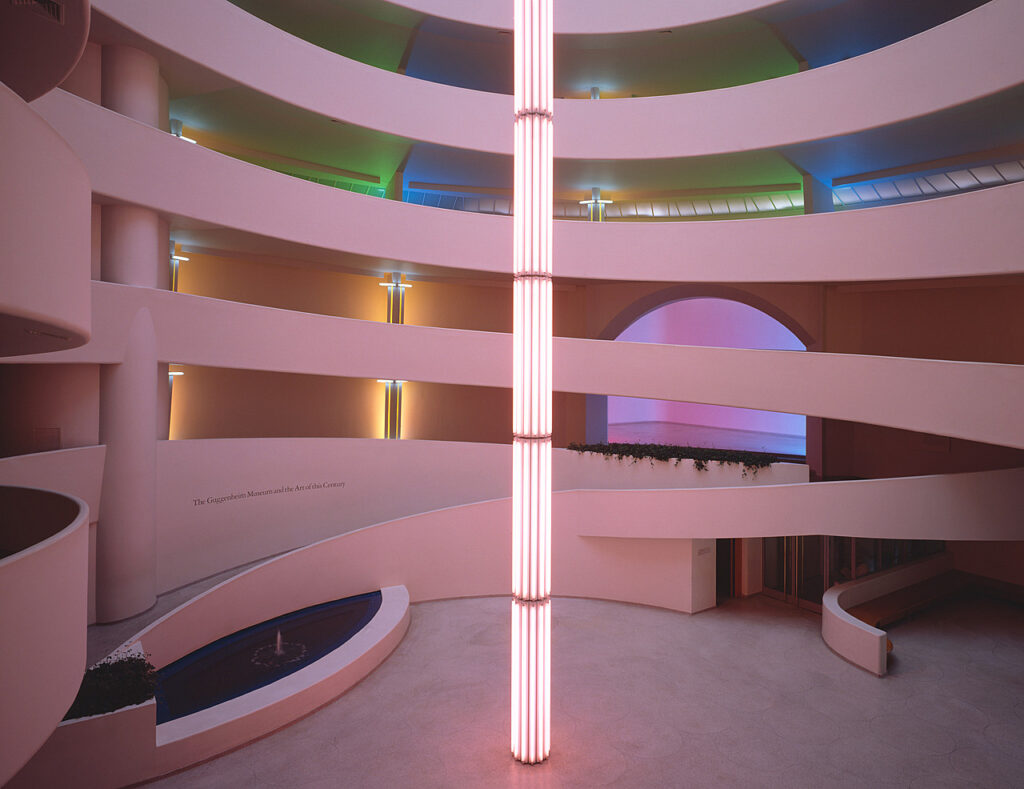“Using inexpensive, standard-sized fluorescent lamps, fixtures and wiring, Dan Flavin fills large rooms with tremendous energy. Some of the 50 objects and installations on view at the Museum of Contemporary Art’s current retrospective are unbearably intense, some are seductive, and some are antagonistic. Radical in conception and execution, the light pieces hover between sculpture and drawing. Indeed, in many cases Flavin thinks like a draftsman — its just that his lines are not marks, but three-dimensional shapes in space that radiate light and color; they exist only so long as his characteristic fluorescent lamps function and receive electric power. These lines are most effective when they have an entire space to command and can stake their claim to it by their reflections on the floor, walls and ceiling.
…
Through constant experimentation, he learned how to cull powerful effects from lamps that were only available in a limited number of standardized lengths, colors and diameters. After making his first light sculptures, Flavin never worked in any other way. Eventually, he acquired such mastery that he could plan a piece after a brief visit to the space and have assistants install it for him.

…
Traversing this massive retrospective of Dan Flavin’s career, if there is a single theme to all his work, it is clear: NO TRESPASSING. Repeatedly, Flavin draws viewers in, then drives them off, prevents them from entering a space, or attacks them with light. Some of his pieces are so bright that we cannot possibly live with them. Where does this seemingly conflicted relationship with his audience come from?

An “artist’s artist,” Flavin came from a modest background, never graduated from college or art school, and was chronically insecure. To protect himself and avoid explaining how he conceived of his light works, he created narrative distractions. He gave his light sculptures literary titles, dedicating many to people he admired like Brancusi, or to friends like Judd, but there was no connection between the work and its title. He seemed to feel a need to do this — and at the same time to tell the world at epic length that he, like James Joyce, had been raised in a narrow Roman Catholic household, but had rebelled and left the Church” (Cassidy, n.d.).
Dan Flavin’s work has always fascinated me. The colors and scale of his work has drawn me into so many of his pieces, even though I’ve only has the opportunity to view most of them through a screen or in the pages of a book. His work is like Duchamp’s cool eccentric aunt, who hides her pain and grief behind bold color choices and an infectious personality. It has a clever way of bringing viewers in and immersing them in the work while simultaneously holding them at arm’s length.


Flavin is one of those artists who I feel a lot of people discount because they feel like his work is easily replicable. When viewing his work at the MET a few years ago, I was surrounded by people saying “I could’ve made that,” without really understanding the medium that Flavin was working with and it’s impact. I appreciated that the article from artnet captured this phenomenon very concisely, emphasizing that Flavin was a master of his chosen medium. Along with his peers, such as Roy Lichtenstein, Helen Frankenthaler, and Jasper Johns, Flavin was monumental in defining the American abstraction movement. While Flavin, and myself, never approved of using “minimalism” to describe his work it’s influence on the movement also shouldn’t go without recognition.
References
- Cassidy, V. (n.d.). No Trespassing: The Art of Dan Flavin. ArtNet https://www.artnet.com/magazineus/reviews/cassidy/cassidy8-4-05.asp
- Dan flavin standing with his work [Photograph]. (n.d.) Ordovas. https://www.ordovasart.com/artist/dan-flavin/
- Flavin, D. (1977). untitled (in honor of Harold Joachim) 3. Pink, yellow, blue, and green fluorescent light, 8 ft. (244 cm) square across a corner. National Gallery of Art. Wasington, D.C..
- Flavin, D. (1970) untitled (to Barnett Newman to commemorate his simple problem, red, yellow, and blue). Yellow, blue, and red fluorescent light height variable, 8 ft. (244 cm) wide across a corner. National Gallery of Art. Washington, D.C..
- Flavin, D. (1992). untitled (to Tracy, to celebrate the love of a lifetime). Pink, green, blue, yellow, daylight, red, and ultraviolet fluorescent light, height variable. Solomon R. Guggenheim Museum. New York, New York.
- Flavin, D. (1971). untitled (to Ward Jackson, an old friend and colleague who, during the Fall of 1957 when I finally returned to New York from Washington and joined him to work together in this museum, kindly communicated).




